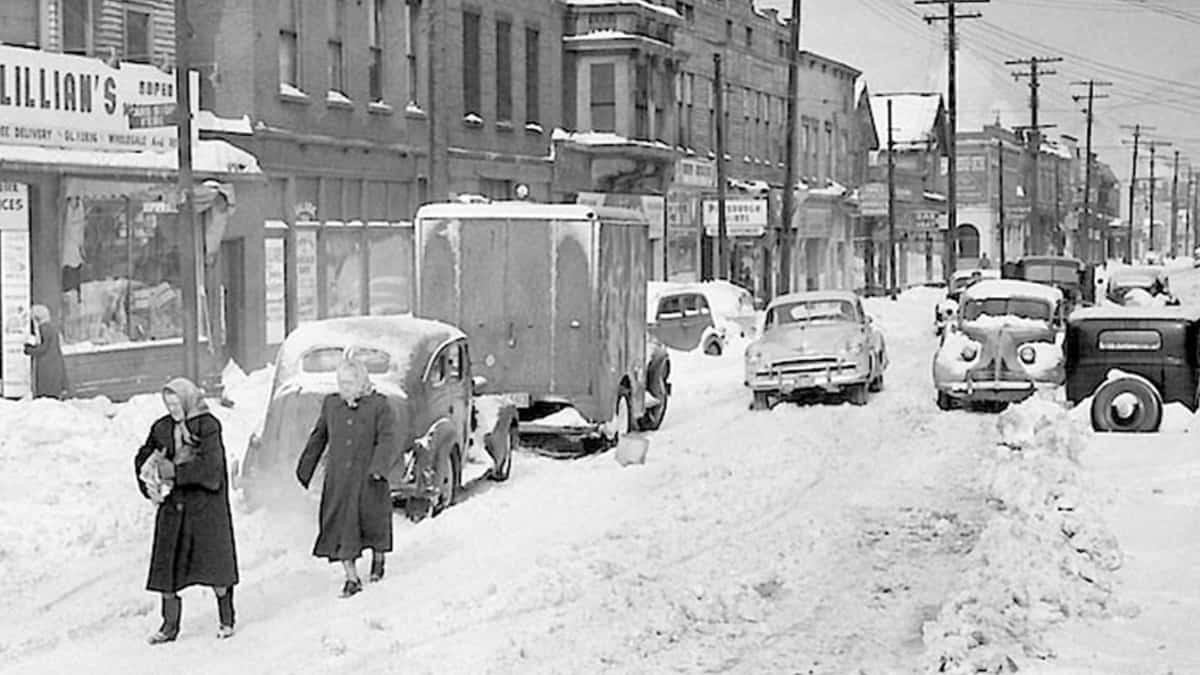Some of the worst storms in U.S. history have hit around Thanksgiving, disrupting transportation and claiming lives. The following are five of the most destructive and deadliest of those storms.
Infamous Portland storm (1898)
This massive storm killed 200 people from Nov. 26 to 28, just after Thanksgiving. It formed off Cape Cod, hitting the New England coast.
More than 24 inches of snowfall piled up in parts of Connecticut, and Boston received more than 12 inches. The storm lasted more than 30 hours and produced wind gusts of 100 mph, reshaping the coastal geography of Massachusetts.
The storm also sank hundreds of ships in Boston Harbor and many at sea. The deadliest shipwreck was the coastal steamship Portland, which lost all hands — 130 passengers and more than 60 crew members. Almost 20 people died on the wood propeller steamship Pentagoet. The Boston Post wrote of the Portland tragedy, “Many a great battle does not present such a list of fatalities as this single wreck.”
New England ice storm (1921)
This stands as one of the nation’s worst ice storms in recorded history, causing at least $10 million in damage. Adjusted for inflation, that’s more than $120 million in 2020.
Telephone wires near Worcester, Massachusetts weighed down by thick ice in late November 1921. (Photo: New England Telephone and Telegraph Company)
More than 3 inches of ice accumulated in many areas, and roughly 100,000 trees were uprooted or damaged. For more than three days, New England remained immobilized. The storm started on the Saturday afternoon after Thanksgiving and ended during the predawn hours of the following Tuesday.
Transportation came to a grinding halt, power outages were widespread and schools and businesses were closed.
Great Appalachian storm (1950)
This large cyclone brought the eastern United States to a standstill. Heavy rains, blizzard conditions and hurricane-force winds killed 353 people and injured 160. The storm hit 22 states, cut off power to 1 million customers and produced $66.7 million in damage (around 10 times that amount in 2020 dollars).
Snowfall totals of 57 inches were measured in parts of West Virginia. Mount Washington, New Hampshire, elevation 6,288 feet, recorded winds of 160 mph. Nearly the entire state of Ohio was blanketed with at least 10 inches of snowfall, with the highest report of 44 inches.
Coastal communities were flooded from New Jersey northward. The storm initially formed in North Carolina on the morning of Nov. 24, the day after Thanksgiving, finally fading Nov. 30.
Hawaii hurricane (1982)
Hurricane Iwa clipped the western Hawaiian Islands on Thanksgiving Day with peak winds of 86 mph and gusts exceeding 100 mph. This was Hawaii’s first direct hit from a hurricane since it became a state in 1959. Iwa caused $200 million in damage, equivalent to more than $500 million in 2020.
There was major damage on the island of Kauai, where the peak storm surge was 6 to 8 feet on the south shore. Fortunately, nobody died.
Hurricane Iwa on Nov. 24, 1982. (Photo: NOAA)
During the worst of the storm, 5,800 people were evacuated from shoreline communities to temporary shelters. Strong waves sank or grounded several small vessels along Kauai’s coast, including 44 of the 45 boats at Port Allen. Winds damaged several small aircraft at Lihue Airport (ICAO code: PHLI) and initially left the entire island without power.
North Carolina tornado (1988)
An F4 tornado tracked 84 miles across six counties in North Carolina the Monday after Thanksgiving. The National Weather Service issued warnings as the twister began carving a path through the northern suburbs of Raleigh.
The tornado — one of the strongest on record in North Carolina — killed four people, including two children in Raleigh, and injured more than 150. Nearly 2,500 homes were demolished, along with more than 75 businesses and several shopping centers.
The tornado spawned from a cluster of thunderstorms that developed over south-central North Carolina just before midnight ET on Nov. 27. The storms became severe as they moved into Wake County from the southwest between 12:45 and 1 a.m. on Nov. 28. The deadly tornado began shortly after 1 a.m., finally lifting a little more than 90 minutes later near Jackson, North Carolina.
Click here for more FreightWaves articles by Nick Austin.
America’s most dangerous roads for truckers: Part 2
Truck drivers’ favorite weather movies of all time
3 ways the supply chain protects freezable freight










